Related Research Articles
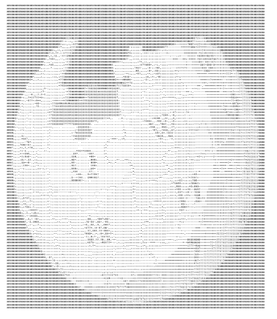
ASCII art is a graphic design technique that uses computers for presentation and consists of pictures pieced together from the 95 printable characters defined by the ASCII Standard from 1963 and ASCII compliant character sets with proprietary extended characters. The term is also loosely used to refer to text based visual art in general. ASCII art can be created with any text editor, and is often used with free-form languages. Most examples of ASCII art require a fixed-width font such as Courier for presentation.

The Graphics Interchange Format is a bitmap image format that was developed by a team at the online services provider CompuServe led by American computer scientist Steve Wilhite on June 15, 1987. It has since come into widespread usage on the World Wide Web due to its wide support and portability between applications and operating systems.
The Portable Document Format (PDF) is a file format developed by Adobe in 1993 to present documents, including text formatting and images, in a manner independent of application software, hardware, and operating systems. Based on the PostScript language, each PDF file encapsulates a complete description of a fixed-layout flat document, including the text, fonts, vector graphics, raster images and other information needed to display it. PDF was standardized as ISO 32000 in 2008, and no longer requires any royalties for its implementation.
Tagged Image File Format, abbreviated TIFF or TIF, is a computer file format for storing raster graphics images, popular among graphic artists, the publishing industry, and photographers. TIFF is widely supported by scanning, faxing, word processing, optical character recognition, image manipulation, desktop publishing, and page-layout applications. The format was created by Aldus Corporation for use in desktop publishing. It published the latest version 6.0 in 1992, subsequently updated with an Adobe Systems copyright after the latter acquired Aldus in 1994. Several Aldus or Adobe technical notes have been published with minor extensions to the format, and several specifications have been based on TIFF 6.0, including TIFF/EP, TIFF/IT, TIFF-F and TIFF-FX.
Digital Picture Exchange (DPX) is a common file format for digital intermediate and visual effects work and is a SMPTE standard. The file format is most commonly used to represent the density of each colour channel of a scanned negative film in an uncompressed "logarithmic" image where the gamma of the original camera negative is preserved as taken by a film scanner. For this reason, DPX is the worldwide-chosen format for still frames storage in most digital intermediate post-production facilities and film labs. Other common video formats are supported as well, from video to purely digital ones, making DPX a file format suitable for almost any raster digital imaging applications. DPX provides, in fact, a great deal of flexibility in storing colour information, colour spaces and colour planes for exchange between production facilities. Multiple forms of packing and alignment are possible. The DPX specification allows for a wide variety of metadata to further clarify information stored within each file.
The computer art scene, or simply artscene, is the community interested and active in the creation of computer-based artwork.
Computer Graphics Metafile (CGM) is a free and open international standard file format for 2D vector graphics, raster graphics, and text, and is defined by ISO/IEC 8632.
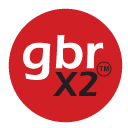
The Gerber format is an open ASCII vector format for printed circuit board (PCB) designs. It is the de facto standard used by PCB industry software to describe the printed circuit board images: copper layers, solder mask, legend, drill data, etc.
ACiD Productions (ACiD) is a digital art group. Founded in 1990, the group originally specialized in ANSI artwork for BBSes. More recently, they have extended their reach into other graphical media and computer software development. During the BBS-era, their biggest competitor was iCE Advertisements.
PHIGS is an application programming interface (API) standard for rendering 3D computer graphics, considered to be the 3D graphics standard for the 1980s through the early 1990s. Subsequently, a combination of features and power led to the rise of OpenGL, which became the most popular professional 3D API of the mid to late 1990s.
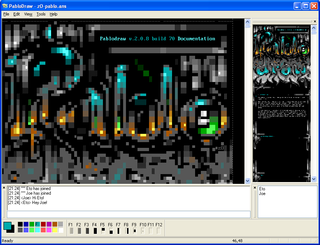
PabloDraw is a cross-platform text editor designed for creating ANSI and ASCII art, similar to that of its MS-DOS-based predecessors; ACiDDraw (1994) and TheDraw (1986).
FILE_ID.DIZ is a plain text file containing a brief content description of the archive in which it is included. It was originally used in archives distributed through bulletin board systems (BBS), and still in the warez scene.
ANSI art is a computer art form that was widely used at one time on bulletin board systems. It is similar to ASCII art, but constructed from a larger set of 256 letters, numbers, and symbols — all codes found in IBM code page 437, often referred to as extended ASCII and used in MS-DOS and Unix environments. ANSI art also contains special ANSI escape sequences that color text with the 16 foreground and 8 background colours offered by ANSI.SYS, an MS-DOS device driver loosely based upon the ANSI X3.64 standard for text terminals. Some ANSI artists take advantage of the cursor control sequences within ANSI X3.64 in order to create animations, commonly referred to as ANSImations. ANSI art and text files which incorporate ANSI codes carry the de facto .ANS file extension.

The Initial Graphics Exchange Specification (IGES) is a vendor-neutral file format that allows the digital exchange of information among computer-aided design (CAD) systems.
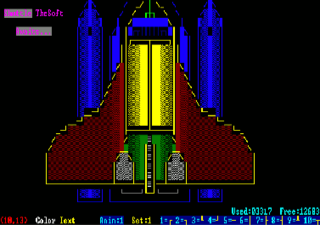
TheDraw is a text editor for MS-DOS to create ANSI and animations as well as ASCII art. The editor is especially useful to create or modify files in ANSI format and text documents, which use the graphical characters of the IBM ASCII code pages, because they are not supported by Microsoft Windows anymore. The first version of the editor was developed in 1986 by Ian E. Davis of TheSoft Programming Services. The last public version of the editor was version 4.63, which was released in October 1993.
Standard Architecture for Universal Comment Extensions or SAUCE, as it is most commonly known, is an open metadata protocol for tagging and describing ASCII text files and other files, most of which generally center on or date back to the era of BBSing. SAUCE is very similar in nature to the MP3 ID3 tag format created in 1996 in that it carries metadata such as the title, author (artist), organization (group), as well as specific hierarchical datatype information depending on what type of file it is describing.
A cue sheet, or cue file, is a metadata file which describes how the tracks of a CD or DVD are laid out. Cue sheets are stored as plain text files and commonly have a .cue filename extension. CDRWIN first introduced cue sheets, which are now supported by many optical disc authoring applications and media players.
This article describes the technical specifications of the OpenDocument office document standard, as developed by the OASIS industry consortium. A variety of organizations developed the standard publicly and make it publicly accessible, meaning it can be implemented by anyone without restriction. The OpenDocument format aims to provide an open alternative to proprietary document formats.
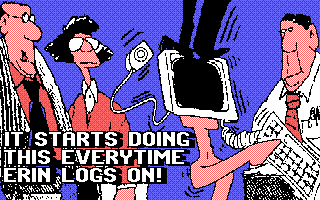
BSAVE and BLOAD are commands in many varieties of the BASIC programming language. BSAVE copies RAM to a binary file, and BLOAD copies the contents of the file to RAM. The term "BSAVE image" could mean any of various raw image formats of video display controllers, or more generally any file containing the raw contents of a section of memory.
References
- ↑ Reubens, Olivier "Tasmaniac" (2013-11-12) [1994-03-01]. "SAUCE – Standard Architecture for Universal Comment Extensions". 0.5. ACiD. Archived from the original on 2019-04-14. Retrieved 2019-06-04. (NB. Contains SAUCE details and specifications.)